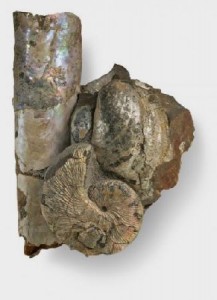Powerful synchrotron scans of Baculites fossils found on American Museum of Natural History expeditions to the Great Plains suggests that the extinct group of marine invertebrates to which they belong, the ammonites, had jaws and teeth adapted for eating small prey floating in the water. One ammonite also provided direct evidence of a planktonic diet because it died with its last meal in its mouth-tiny larval snails and crustacean bits. The detailed description of internal structure of ammonites, published by a Franco-American research team this week in Science, also provides new insights into why ammonites became extinct 65.5 million years ago when an asteroid impact led to the demise of the world’s nonavian dinosaurs and much of the plankton.

These are fossils of ammonites, including Baculites (the long straight-shell pictured vertically), from Upper Cretaceous deposits in South Dakota. – S. Thurston
“I was astonished when I saw the teeth for the first time, and when I found the tiny plankton in the mouth,” says first author Isabelle Kruta of the Département Histoire de la Terre, Muséum National d’Histoire Naturelle in Paris, France. Kruta began the project as an Annette Kade fellow at the American Museum of Natural History. “For the first time we could observe these delicate, exceptionally well-preserved structures and obtain information on the ecology of these enigmatic animals.”
“When you take into consideration the large lower jaws of ammonites in combination with this new information about their teeth, you realize that these animals must have been feeding in a different way from modern carrion-eating Nautilus,” says Neil Landman, curator in the Division of Paleontology at the American Museum of Natural History. “Ammonites have a surprisingly large lower jaw with slender teeth, but the effect is opposite to that of the wolf threatening to eat Little Red Riding Hood. Here, the bigger mouth facilitates feeding on smaller prey. ”
Ammonites are extinct relatives of the squid and octopus; the Nautilus is similar in appearance to many ammonites but is a more distant relative. Ammonites appeared about 400 million years ago (the Early Devonian) and experienced an explosive radiation in the early Jurassic. In fact, ammonites became such an abundant and diverse part of the marine fauna that they are, for paleontologists, classic “index” fossils used to determine the relative ages of rocks.
Until recently, the role of ammonites in the marine food web was unknown, although some previous research by Landman and colleagues on the shape of the jaw, as well as a 1992 paper by Russian scientists that reconstructed some of the internal structures by slicing fossils, provided clues. The current study used synchrotron X-ray microtomography to digitally reconstruct the mouths of three fossils found in South Dakota. The three dimensional reconstructions are so high in quality that the jaws and teeth are revealed in their complete form.
“X-ray synchrotron microtomography is currently the most sensitive technique for non-destructive investigation of the internal structure of fossils,” says Paul Tafforeau of the European Synchrotron Radiation Facility. “For this study, we tested specimens after an initial fossil preparation and scanning on more conventional machines by Kruta failed to provide enough detail. The synchrotron results were so impressive that we scanned all available samples, discovering nearly each time radula, and, for one of them, plankton. ”
“The plankton in the Baculites jaws is the first direct evidence of the trophic habits of the uncoiled ammonites and helps us understand the evolutionary success of these ammonites in the Cretaceous,” says Fabrizio Cecca of the Laboratoire de Paléontologie, Université Pierre et Marie Curie in Paris.
Ammonite jaws lie just inside the body chamber. The research team’s new scans of Baculites, a straight ammonite found worldwide, confirms older research that ammonites had multiple cusps on their radula, a kind of tongue covered by teeth that is typical of mollusks. The radula can now be seen in exquisite detail: the tallest cusp is 2 mm high, tooth shape varies from saber to comb-like, and teeth are very slender. The jaw is typical of the group of ammonites (the aptychophorans) to which Baculites, belongs. In addition, one specimen has a tiny snail and three tiny crustaceans in its mouth; one of the crustaceans is even cut in two pieces. Because these planktonic fossils are not found anywhere else on the specimen, the team thinks that the specimen died while eating its last meal rather than being scavenged by these organisms after death.
“Our research suggests several things. First, the radiation of aptychophoran ammonites might be associated with the radiation of plankton during the Early Jurassic,” says Landman. “In addition, plankton were severely hit at the Cretaceous-Tertiary boundary, and the loss of their food source probably contributed to the extinction of ammonites. This research also has implications for understanding carbon cycling during this time.”
Isabelle Rouget, Laboratoire de Paléontologie, Université Pierre et Marie Curie in Paris, agrees, adding that “we now realize that ammonites occupied a different niche in the trophic web than we previously thought.”
Courtesy: news release issued by the American Museum of Natural History



 August 12th, 2012
August 12th, 2012  Riffin
Riffin  Posted in
Posted in  Tags:
Tags: 